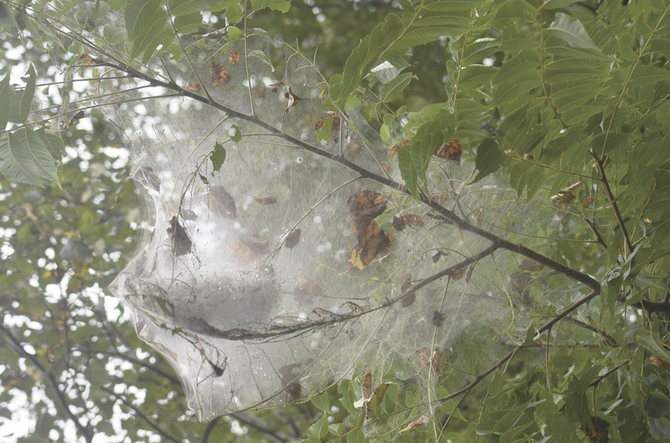If someone were to mention “oil” to you, what would be your first thought? With Thanksgiving just around the corner, maybe you would think of the olive oil you need for roasting potatoes. Or maybe you would think of the drive across state to visit family for the holidays and the thousands of oil wells that dot the landscape along the way. Speaking of holiday driving, maybe your first thought is of the oil change you need to get done on your car before undertaking the annual holiday trip. Then again, with holiday stresses beginning to build, maybe your first thoughts are of needing to break out the essential oil diffuser and some lavender oil to help you relax. Regardless of the type of oil that first comes to mind, there’s one type that could be absolutely essential to the health of your outdoor plants (especially trees, shrubs, and bushes), but is all-too-often forgotten about during this busy time of year: dormant oil.
What is Dormant Oil?

Dormant oil is a type of horticultural oil that is designed to be used on woody plants during their dormant season (late fall through early spring), as a non-chemical treatment for a variety of pests that overwinter on these plants. So what exactly are woody plants? As their name suggests, they are trees, bushes, and shrubs. And what is a horticultural oil? They are generally highly refined petroleum oils, though can sometimes be plant-derived as well, and are specially refined for use on plants. They differ significantly from other common household oils and one cannot be substituted for the other. In addition, horticultural oils commonly have an emulsifier added so that they can be combined with water for safe and thorough application to the affected areas of plants via the use of a power sprayer.
How Does Dormant Oil Work?
When dormant oil is applied to a woody plant it acts primarily as a physical means of pest control. Its exact effects can differ based on the pest it interacts with, but overall it will affect a pest in one of three main ways: suffocation, disruption of cell membranes, and repellent. For most pests, the oil will coat the spiracles (air holes) that they use to breathe and the pest will die from asphyxiation. However, for some pests the oil will act as a sort of poison by interacting with the pest’s fatty acids and interfering with their metabolism. In addition to killing pests, the oil can act as a deterrent for some species and will keep them from feeding on the plant or laying eggs on the plant. Regardless of which effect the pest is susceptible to, dormant oil is a highly effective way to eliminate a pest problem before an issue becomes an infestation, and before harmful pests can damage a plant’s spring growth.

Which Pests is Dormant Oil Effective Against?
As a rule of thumb, dormant oil is effective against most pests that overwinter as eggs on woody plants. These are primarily: caterpillars (including webworms and army worms), mites, scale insects, aphids, lace bugs, leaf beetle larvae, and plant bugs. In addition, dormant oil can sometimes be used for control of some fungi, specifically powdery mildew, rust, and sooty mold.
Is Dormant Oil Dangerous?
When you have dormant oil applied by a Bug Dude technician, it is an extremely safe method of pest control. Not only is it safe for people and pets, it’s safe for wildlife and crops. In addition, though it is a broad-spectrum method of control (meaning that it is not targeted to a specific pest, and instead will affect a wide range of pests), it is generally less harmful to beneficial insects than chemical pest control methods. The only danger that this treatment poses is if it’s performed incorrectly (for example, as a DIY attempt); at that point it could do significant damage to the plant you are trying to help. There are several factors that a Bug Dude technician will take into consideration when determining if a plant is eligible for a dormant oil treatment. Those factors are: if the pest in question is susceptible to the oil, if the plant is in good enough health to be treated, if the plant is of a variety that is highly sensitive to the treatment, if the weather is appropriate for a treatment, and where exactly the oil needs to be sprayed to be effective. If inaccurately applied, dormant oil can discolor or weaken an infested plant, which is why it’s always important to call the experts at The Bug Dude @ 800-310-BUGS (2847) for any pest control needs.

How do I Know if I Need a Dormant Oil Treatment?
If you’re wondering if your trees, shrubs, and bushes are in need of a dormant oil treatment, the first thing to do is think about how they fared over the past year. Did you see signs of webworm webbing in the branches? Were the leaves being heavily eaten by pests? Did you see an abundance of aphids, mites, or scale insects on the plants? Did you have an issue with army worms in your yard? Did you get your plants treated by The Bug Dude for any of the pests listed in the “Which Pests is Dormant Oil Effective Against?” section? Are you currently seeing pests on the plants? Overall, were the plants healthy and thriving or did they seem to be struggling? If you answered yes to any of these questions, then call The Bug Dude at 817-354-5350 and have an expert technician out to evaluate the plant in question and let you know if it’s a good candidate for a dormant oil treatment.

When Should I Get a Dormant Oil Treatment?
As stated earlier, dormant oil is designed to be used during the dormant stage of woody plants, this means sometime between late fall and early spring. As a general guide, it’s after the leaves have fallen and before the tree begins to bud. However, the timing is even more specific than that, because the treatment needs to be done on a day when the temperature is not too warm and not too cold: ideally in the 50 to 70 degree range; it absolutely cannot be done when the temperature is below freezing. Beyond the temperature, the ideal day for a treatment is one with no rain, low humidity, and no wind. When treatment is applied in the ideal conditions, it allows the oil to give complete coverage and ensure utmost efficacy, while also reducing the risk of any plant damage.
In general, the ideal weather conditions for a dormant oil spray occur mostly in November and March, though with Texas weather being unpredictable at best (remember the record-setting winter storm of 2021), there’s no time like the present to schedule a dormant oil treatment.
With Thanksgiving fast approaching and Christmas on its heels, it’s easy to get wrapped up in all the joys (and stresses) of the holiday season and forget that your yard needs more attention than simply a good raking and some decorations. So, this Thanksgiving, if you want your trees to be as thankful for you as you are for them, call The Bug Dude at 817-354-5350 and discuss getting a dormant oil treatment done by one of our experts to help keep your plants pest-free and healthy in the coming year.
Further Reading:
“Dormant Oil Sprays” – keith.hansen, Texas A&M AgriLife Extension, East Texas Gardening
“Pesticide Profile: Horticultural Oil” – Miri Talabac, Horticulturist & Coordinator, HGIC, University of Maryland Extension
“Insect Control: Horticultural Oils – 5.569” – W.S. Cranshaw, Colorado State University Extension entomologist and professor, bioagricultural sciences and pest management; and B. Baxendale, Teikyo Loretto Heights University professor, botany, Denver, Colorado State University Extension
“Horticultural Oils – What a Gardener Needs to Know” – Martha Barajas, University of Nevada, Reno, Extension: College of Agriculture, Biotechnology & Natural Resources
Author Bio: Alissa Breach has been gaining knowledge and experience around pest control concerns over the last 13 years while working for Mid-Cities Pest Control. She has a creative writing BA from UW-Madison and is always pursuing new and interesting writing projects.




